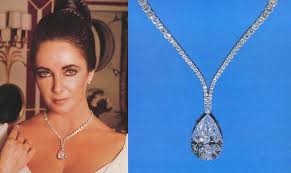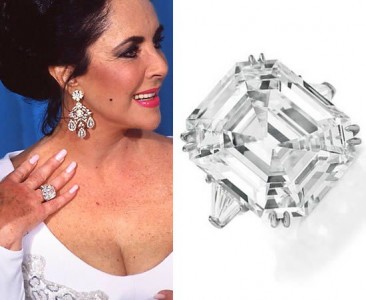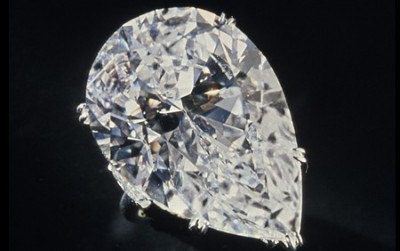More than any woman throughout history, Elizabeth Taylor’s name has been tied to beautiful diamond jewelry and magnificent gems. Most were well-publicized gifts which she received from her fifth husband, the late Richard Burton.
Richard Burton’s first jewelry purchase for Elizabeth Taylor was the 33.19-carat Asscher-cut Krupp Diamond, in 1968. This had formerly been part of the estate of Vera Krupp, second wife of the steel magnate Alfred Krupp. Miss Taylor wears this diamond in a ring. She has worn it in a number of her post-1968 films, during her interview on Larry King Live in 2003, and just about everywhere else she goes. Next came the La Peregrina Pearl for which Burton paid £15,000. The stone has a long and complex history. For Elizabeth’s 40th birthday in 1972 Richard Burton gave her a heart-shaped diamond known as the Taj-Mahal. The diamond is fairly large and flat, with an Arabic inscription on either side. It is set with rubies and diamonds in a yellow gold rope-pattern necklace. “I would have liked to buy her the Taj-Mahal,” he remarked, “but it would cost too much to transport. This diamond has so many carats, it’s almost a turnip.” Then he added, “Diamonds are an investment. When people no longer want to see Liz and I on the screen, then we can sell off a few baubles.”
 By far the best known of Richard Burton’s purchases was the 69.42-carat pear-shape diamond, later to be called the Taylor-Burton Diamond. It was cut from a rough stone weighing 240.80 carats found in the Premier Mine in 1966 and subsequently bought by Harry Winston. Here there is a coincidence: Eight years before, another cleavage of almost identical weight (240.74 carats) had been found in the Premier. Harry Winston bought this stone too, commenting at the time, “I don’t think there have been half a dozen stones in the world of this quality.” This wouldn’t be the first time the Premier Mine would have the last word because the 69.42-carat diamond cut from the later discovery is a D-color Flawless stone.
By far the best known of Richard Burton’s purchases was the 69.42-carat pear-shape diamond, later to be called the Taylor-Burton Diamond. It was cut from a rough stone weighing 240.80 carats found in the Premier Mine in 1966 and subsequently bought by Harry Winston. Here there is a coincidence: Eight years before, another cleavage of almost identical weight (240.74 carats) had been found in the Premier. Harry Winston bought this stone too, commenting at the time, “I don’t think there have been half a dozen stones in the world of this quality.” This wouldn’t be the first time the Premier Mine would have the last word because the 69.42-carat diamond cut from the later discovery is a D-color Flawless stone.
After the rough piece of 240.80 carats arrived in New York, Harry Winston and his cleaver, Pastor Colon Jr. studied it for six months. Markings were made, erased and redrawn to show where the diamond could be cleaved. There came the day appointed for the cleaving, and in this instance the usual tension that surrounds such an operation was increased by the heat and glare of the television lights that had been allowed into the workroom. After he had cleaved the diamond, the 50-year-old cleaver said nothing — he reached across the workbench for the piece of diamond that had separated from it and looked at it through his horn-rimmed glasses for a fraction of a second before exclaiming “Beautiful!” This piece of diamond rough weighed 78 carats was expected to yield a stone of about 24 carats, while the large piece, weighing 162 carats, was destined to produce a pear shape diamond whose weight had originally been expected to be about 75 carats.
In 1967 Winston sold the pear shape diamond to Mrs. Harriet Annenberg Ames, the sister of Walter Annenberg, the American ambassador in London during the Richard Nixon administration. Two years later, she sent the diamond to Parke-Bernet Galleries in New York to be auctioned explaining her decision with this statement:
“I found myself positively cringing and keeping my gloves on for fear it would have been seen, I have always been an extremely gregarious person and I did not enjoy that feeling. The diamond sat in a bank vault for years. It seemed foolish to keep it if one could not use it. As things are in New York one could not possibly wear the diamond publicly.”
The diamond was put up for auction on October 23rd, 1969, on the understanding that it could be named by the buyer. Before the sale speculation was prevailing as to who was going to bid for the diamond, with the usual international names being kicked around by the columnists. Elizabeth Taylor was one name among them and she did indeed have a preview of the diamond when it was flown to Switzerland for her to have a look at, then back to NYC under precautions described as “unusual”.
The auctioneer began the bidding by asking if anyone would offer $200,000, at which the crowded room erupted with a simultaneous “Yes”. Bidding began to climb, and with nine bidders active, rushed to $500,000. At $500,000 the individual bids increased in $10,000 increments. At $650,000 only two bidders remained. When the bidding reached $1,000,000, Al Yugler of Frank Pollack, who was representing Richard Burton, dropped out. Pandemonium broke out when the hammer fell and everyone in the room stood up, resulting in the auctioneer not being able to identify who won, and he had to call for order. The winner was Robert Kenmore, the Chairman of the Bored of Kenmore Corporation, the owners of Cartier Inc., who paid the record price of $1,050,000 for the diamond, which he promptly named the ‘Cartier’. The previous record for a jewel had been $305,000 for a diamond necklace from the Rovensky estate in 1957. A diamond attached to the necklace weighed approximately 46.50 carats and is thought to be the Excelsior III Diamond. It appeared in an article about diamonds in the April 1958 issue of National Geographic magazine, along with the Niarchos and Nepal.
As well as Richard Burton, Harry Winston had also been an under-bidder at the sale. But Burton was not finished yet and was determined to acquire the diamond. So, speaking from a pay-phone of a well-known hotel in southern England, he spoke to Mr. Kenmore’s agent. Sandwiched between the lounge bar and the saloon, Burton negotiated for the gem while continually dropping coins into the phone. Patrons quietly sipping their drinks would have heard the actor’s loud tones exclaiming “I don’t care how much it is; go and buy it.” The very next day Richard Burton purchased the diamond, for an undisclosed sum of money, to give to his wife, Elizabeth Taylor. As part of the agreement, Kenmore insisted that Cartier would be able to display the stone in their New York and then Chicago store, although it would be henceforth known as the Taylor-Burton.
Harry Winston
More than 6000 people a day flocked to Cartier’s New York store to see the Taylor-Burton, the crowds stretching down the block. But an article in the New York Times was distinctly sour on the subject. Under the headline of ‘The Million Dollar Diamond’ appeared the following comment:
“The peasants have been lining up outside Cartier’s this week to gawk at a diamond as big as the Ritz that cost well over a million dollars. It is destined to hang around the neck of Mrs. Richard Burton. As someone said, it would have been nice to wear in the tumbrel [a farm cart for carrying dung; carts of this type were used to carry prisoners to the guillotine during the French Revolution] on the way to the guillotine.”
Shortly afterwards Miss Taylor wore the Taylor-Burton in public for the first time when she attended Princess Grace’s 40th birthday party in Monaco. The diamond was flown from New York to Nice, Italy in the company of two armed guards hired by Burton and Cartier. In 1978, following her divorce from Richard Burton, Miss Taylor announced that she was putting the diamond up for sale and was planning to use part of the proceeds to build a hospital in Botswana. In June of 1979 Henry Lambert, the New York jeweler, stated that he had bought the Taylor-Burton Diamond for $5,000,000.
Shortly afterwards Miss Taylor wore the Taylor-Burton in public for the first time when she attended Princess Grace’s 40th birthday party in Monaco. The diamond was flown from New York to Nice, Italy in the company of two armed guards hired by Burton and Cartier. In 1978, following her divorce from Richard Burton, Miss Taylor announced that she was putting the diamond up for sale and was planning to use part of the proceeds to build a hospital in Botswana. In June of 1979 Henry Lambert, the New York jeweler, stated that he had bought the Taylor-Burton Diamond for $5,000,000.
By December he had sold the diamond to its present owner, Robert Mouawad. Soon after, Mr. Mouawad had the stone slightly recut and it now weighs 68.09 carats. Before the recutting, the curved half of the stone’s girdle had a very round outline; it is now a little straighter at that end. It also had a small culet, which was made even smaller after the recut.


